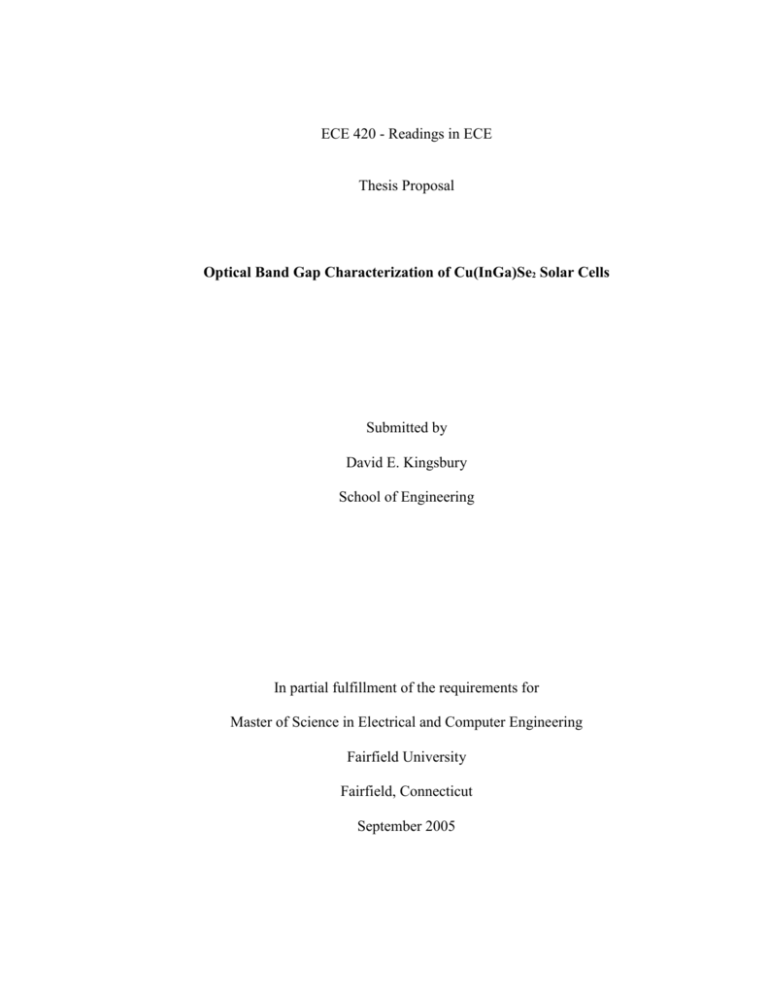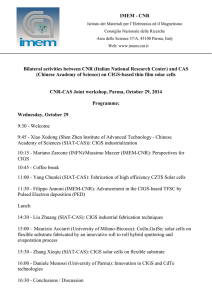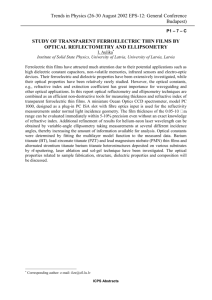Draft Thesis Proposal
advertisement

ECE 420 - Readings in ECE Thesis Proposal Optical Band Gap Characterization of Cu(InGa)Se2 Solar Cells Submitted by David E. Kingsbury School of Engineering In partial fulfillment of the requirements for Master of Science in Electrical and Computer Engineering Fairfield University Fairfield, Connecticut September 2005 Abstract During the creation of Cu(InGa)Se2 solar cells, the proportion of In to Ga directly affects the band gap and hence determines the minimum photon energy that will be absorbed. While various methods exist to measure the band gap, this thesis will use a nondestructive method that can be used during manufacturing to determine the band gap by optically measuring the complex refractive index using ellipsometry. The complex refractive index measurements will be compared to complex refractive index measurements of single crystal data taking by MI Alonso with known proportions of In and Ga.1 This thesis will involve setting up an ellipsometer. After collecting and processing the ellipsometry data the complex refractive index for each sample will be determined. Finally a computer program to find the best fit of the data compared to the single crystal reference data will be written to determine the ratio of In to Ga and estimate the band gap. Errors throughout the entire process will be investigated and documented. ii Table of Contents 1.0 Introduction ................................................................................................................... 1 1.1 Problem Statement .................................................................................................... 2 1.2 Approach ................................................................................................................... 2 1.3 Motivation ................................................................................................................. 2 2.0 Spectral Ellipsometry .................................................................................................... 3 3.0 Experimental Results .................................................................................................... 4 4.0 Conclusion .................................................................................................................... 5 5.0 Literature Cited ............................................................................................................. 6 iii 1.0 Introduction The energy absorption properties of solar cells are governed by many factors. The most important factor is how the solar cell absorbs light and converts a photon’s energy to electricity. In order for a direct band gap solar cell to absorb photons, the energy of the photon needs to be at least equal to or larger than the energy gap between the valence and conduction bands. In reality, the incident solar radiation that strikes the earth’s surface contains a spread of energy mostly from infrared to ultraviolet with the incident power peaking between 1 – 1.5 eV. As a consequence, it is desirable to shift a solar cell’s band gap to maximize the power that can be absorbed. For Cu In1-x Gax Se2 (CIGS) solar cells the band gap can be adjusted by changing the amount of In and Ga that is used during its formation. As the amount of Ga increases from 0 to 1, the band gap increases from 1.0 to 1.6 eV. As more Ga is added, displacing In, the semiconductor donor levels drop while the acceptor levels remain essentially unchanged thus causing the band gap to increase.2 As a result of the complicated chalcopyrite structure (diamond-like with a tetragonal unit cell with distortion) of CIGS solar cells, various intrinsic defects are possible that lead to a number of possible electronic transitions. 3 Consequently, measuring the effective band gap requires determining the material characteristics of a given sample. Ellipsometry is a technique developed by Paul Drude in Germany and Lord Rayleigh in Great Britain over 100 years ago to study polarized light reflected from thinfilm coated solid and liquid surfaces. However it was not until the 1970s when computer processing power was sufficient to fit the experimental data to the physics-based first 1 principles equations that the phase differences between incident and reflected light could be used to determine material properties such as the index of refraction.4 1.1 Problem Statement The goal of this thesis is to develop a nondestructive optical process to determine the band gap and measure the amount of In and Ga in CIGS solar cells. 1.2 Approach Spectroscopic ellipsometry (SE) will be used to measure the complex refractive index of several CIGS samples. Spectroscopic ellipsometry measures the change in polarization of light that is shown at a material from an oblique angle. The light interacts with each layer of a thin film material, with some light being reflected at each interface, creating an interference pattern representative of the material’s optical properties, including complex refractive index.5 After the interference pattern is collected at several polarizations and processed, the complex refractive index will be determined using commercially available equipment and processing software. Next, the SE data will be compared to complex refractive index measurements collected by [Alonso] with single crystal CIGS with their known band gap to In/Ga content. Software will be written to provide the best fit between the measured data and data interpolated from [Alonso] measurements, since those measurements were taken with discrete amounts of In/Ga. 1.3 Motivation The motivation for this thesis comes from a need to quickly and nondestructively measure the amount of In and Ga present in a semiconductor solar cell during fabrication. This will allow the In to Ga content to be modified and corrected during fabrication. 2 While some post-process annealing in Se-rich or Se-poor environments can be performed, the proportion of In to Ga has a greater impact on the final semiconductor band gap and hence its potential efficiency and usefulness. 2.0 Spectral Ellipsometry Equipment to perform spectral ellipsometry is commercially available to both collect and process sample data. Figure 1 illustrates how linearly polarized light reflects off a sample at an oblique angle resulting in elliptically polarized light. Figure 1. Geometry of an Ellipsometric Measurement6 The polarization change is quantified by measuring Psi, ψ, and Delta, Δ. Psi and Delta are related to the ratio of the Fresnel reflection coefficients, Rp and Rs, for s and p polarized light respectively as given in equation (1). ~ R tan( )e i ~p Rs 3 (1) Note ψ is the ratio of the magnitude of Rp and Rs while Δ is the phase difference. Ellipsometry is most sensitivity at the Brewster angle (Δ = 90 degrees) which is when Rp is at a minimum and the difference between Rp and Rs is at a maximum. The tangent of the Brewster angle is also defined as the ratio of the index of refraction of two mediums: n2 tan B n1 (2) where n is the refractive index which describes the propagation speed of light through a medium. The second optical constant of a material is k. k is the extinction coefficient describing how much energy a material absorbs from the light. The complex refractive index, equation (3), combines both n and k into one wavelength dependent equation.6 ~ ( ) n( ) i k ( ) n (3) 3.0 Experimental Results It is anticipated that the complex refractive indices deduced from the SE data will have the same shape and generally fall within the bounds established by [Alonso’s] data. However it is quite possible that variations in the solar cell processing or measurement techniques may create intrinsic differences between the two sets of data resulting in a poor correlation. As previously mentioned, the [Alonso] reference data were taken using discrete proportions of In to Ga and in order to get a closer approximation, interpolation will be employed to derive reference data with In to Ga ratios between Alonso’s data. The coefficient of determination, r2, will be calculated as each dataset is fit to the 4 reference dataset and a binary search of In to Ga ratios will be employed until r2 is maximized. 4.0 Conclusion After reading numerous chapters in the Handbook of Photovoltaic Science and Engineering, and articles on the National Renewable Energy Laboratory website (www.nrel.gov) I have researched the proposed measurement technique to ensure that ellipsometry can be used to optically characterize CIGS solar cells. Ellipsometry is a nondestructive measurement technique that involves studying the change in polarization of reflected light across a range of wavelengths. In order to complete this thesis, additional literary research will be conducted to further understand ellipsometry and its application to semiconductor material characterization in general and CIGS in particular. Several additional journal articles which cite the listed references have been identified for review. Access to a spectroscopic ellipsometer will be needed as well as CIGS solar cells to complete this research. To simplify the optical measurements, it is preferable to get solar cells samples that do not have front contacts (i.e. pulled from a manufacturing line prior to being completed) which will eliminate interference from the front contact. In summary, I am proposing to ascertain the band gap and ratio of In to Ga present in CIGS solar cells by comparing the measured complex refractive index using spectroscopic ellipsometry to reference data taken by [Alonso]. 5 5.0 Literature Cited Alonso MI, et al., “Optical functions of chalcopyrite CuGaxIn1-xSe2 alloys”, Applied Physics A-Materials Science & Processing 74 (5) pp 659-664 May 2002 1 2 Luque, Antonio and Steven Hegedus editors, Handbook of Photovoltaic Science and Engineering, 2003. 3 Wasim S, Solar Cells 16, 317-333 (1986). Hilfiker, James, et al., “Automated Spectroscopic Ellipsometry”, The Industrial Physicist, March 1996, pp. 30-34. 4 Hilfiker, J.N., et al. “Spectroscopic Ellipsometry (SE) for materials characterization at 193 and 157 nm”, Semiconductor Fabtech, 17th Edition. 5 6 Woollam, J.A. Co, Inc. “Ellipsometry Basics”, http://www.jawoollam.com/Tutorial_1.html 6





